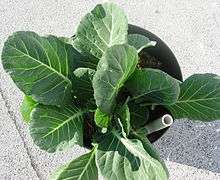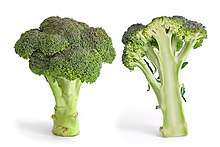Acephala group
The acephala group refers to any type of Brassica which grows without the central 'head' typical of many varieties of cabbage. These are included within the species Brassica oleracea, such as Kale (Brassica oleracea var. acephala).[1] The name literally means "without a head" in contrast to those varieties known as capitata or "with a head". This group includes a number of species, both wild and cultivated, many of which are grown for their edible leaves and flowers.
| Acephala group | |
|---|---|
 Three young plants of non-heading collard greens growing in a small office wastebasket with a water reservoir at the bottom | |
| Species | Brassica oleracea |
| Cultivar group | Acephala Group |
| Origin | unknown |
| Cultivar group members | Many; see text. |
Groups of cultivars
Different sources break down the Brassica genus into different grouping as shown below:
Mabberley
Mabberley (q.v.) has these groups: Napobrassica Group / Pabularia Group / Acephala Group / Alboglabra Group / Botrytis Group / Capitata Group / Gemmifera Group / Gongylodes Group / Italica Group / Tronchuda Group / Chinensis Group / Japonica Group / Pekinensis Group / Perviridis Group / Rapifera Group
Royal Botanic Gardens Kew
Royal Botanic Gardens Kew[2] has eight groups: Acephala Group (kale, borecole, collards) / Alboglabra Group (Chinese kale, Chinese broccoli, gai lan, kai lan) / Botrytis Group (broccoli, cauliflower, broccoflower, calabrese) / Capitata Group (cabbage, Savoy cabbage, red cabbage) / Gemmifera Group (sprouts, Brussels sprouts) / Gongylodes Group (kohlrabi, knol-kohl) / Italica Group (purple sprouting, sprouting broccoli) / Tronchuda Group (Portuguese cabbage, seakale cabbage)
Acephala group
The Acephala group of cultivars or variety for the species Brassica oleracea includes:[3]
- kale, or borecole, or colewort[4]
- curly kale
- American English collard greens, or collard
- U.K. English spring greens
- decorative kale,[5] ornamental kale,[6] flowering kale,[7] flowering cabbage,[8] or ornamental cabbage[9]
- Jersey cabbage,[10] long jack,[10] walking-stick cabbage,[11] cow cabbage,[12] Jérriais lé grand chour à vaque [i.e., big cabbage for cows],[13] Jérriais lé chour [i.e., cabbage],[14] tree cabbage,[15] or Jersey kale,[16] or Brassica oleracea longata[17] The long woody stems are used for walking sticks and the foliage for cow-fodder.[18]
- Scotch kale[19]
Acephala means "no head"[20] as the plants have leaves with no central head; the opposite arrangement of white cabbage, or Savoy cabbage. Each cultivar has a different genome owing to mutation,[21] evolution, the ecological niche,[22] and intentional plant-breeding by man. Mabberley (1997, p. 120) has the Acephala group in three sub-groups: kale, borecole, and collards.[23]
References
- Random House Webster's College Dictionary, New York 1992, p. 736 (s.v. kale)
- "Brassica oleracea (wild cabbage)". kew.org. Royal Botanic Gardens.
- "RHS Plant Finder". rhs.org.uk. Royal Horticultural Society. Retrieved 25 November 2014.
- (Quote.) "Originally, a general name for any plant of the cabbage kind, genus Brassica (of which the varieties were formerly less distinct than now)." ("colewort, n." OED Online. Oxford University Press, September 2014. Web. 26 November 2014.)
- "Plants for the Front Porch". Henry Homeyer: The Gardening Guy. Henry Homeyer.
- "Ornamental Kale/Ornamental Cabbage". The Georgia Gardener. Walter Reeves / The Simple Gardener, Inc.
- "Flowering kale". Better Homes & Gardens. Meredith Corporation.
- "About Flowering Cabbage Plants". Gardenguides.com. Demand Media.
- James Alexander-Sinclair. "The ornamental cabbage". Gardenersworld.com. Immediate Media Company Ltd. Archived from the original on 2014-07-11. Retrieved 2014-11-26.
- "BBC History Domesday: Cabbage Walking Sticks". bbc.co.uk. BBC.
- "Kale 'Walking Stick' Brassica oleracea (Acephala Group), Borecole, Walking Stick Cabbage". Thompson & Morgan. Archived from the original on 14 December 2013.
- "Giant cabbage". Jersey Evening Post. Archived from the original on 2014-06-06. Retrieved 2014-11-26.
- A.J. Andrews. "How to Grow Giant Walking Stick Cabbage". homeguides.sfgate.com. Hearst Communications Inc.
- "Jérriais to English dictionary". Freelang.
- "Perennial vegetables: Tree cabbage". The Cottage Smallholder.
- "Jersey Kale, Walking Stick Cabbage, Cow Cabbage, Tree Cabbage, Chou Cavalier". Chiltern Seeds. Archived from the original on 2014-11-26. Retrieved 2014-11-26.
- Jodi Torpey (8 September 2012). "Walking stick kale really works". Vegetable Gardener.
- Mabberley, D. (1997) Mabberley's plant-book : A portable dictionary of plants, their classification and uses. 3rd ed. Cambridge: Cambridge University Press.
- "Definition of Scotch kale in English". Oxford Dictionaries.
- "Merriam-Webster :Acephala". Merriam-Webster.(subscription required)
- "Courses: "Genome evolution and mutation"". Retrieved 25 November 2014.

- Knowles, LL; Carstens, BC; Keat, ML (2007-06-05). "Coupling Genetic and Ecological-Niche Models to Examine How Past Population Distributions Contribute to Divergence". Current Biology. 17 (11): 940–946. doi:10.1016/j.cub.2007.04.033. PMID 17475496.
- Mabberley, q.v.
External links

